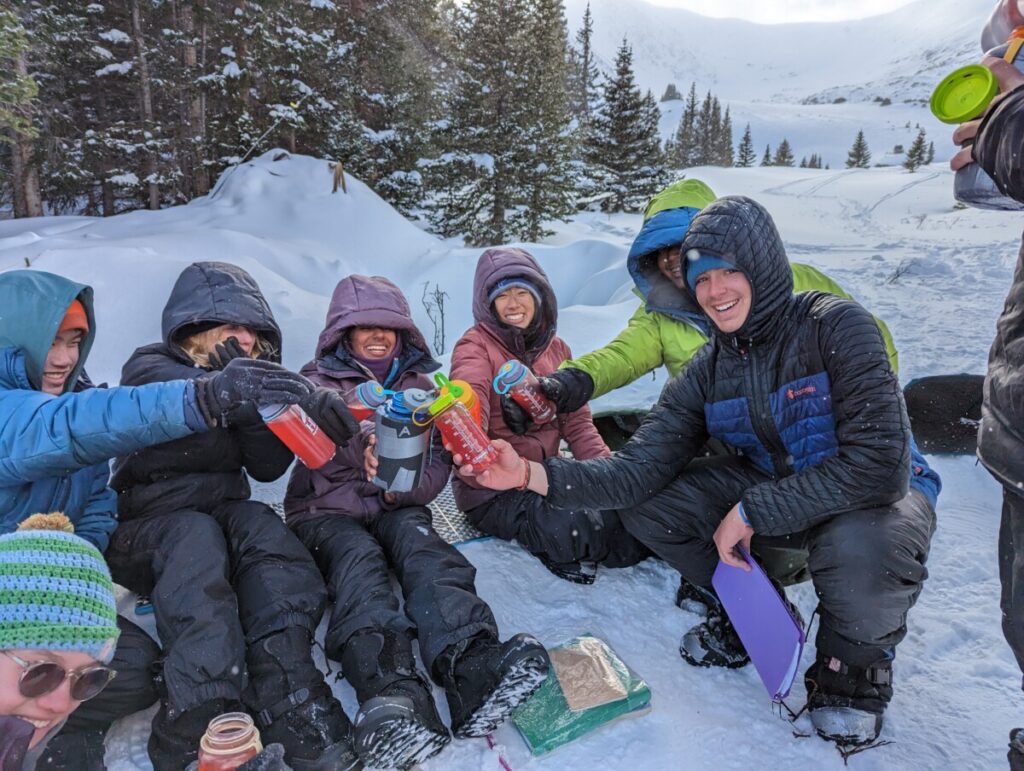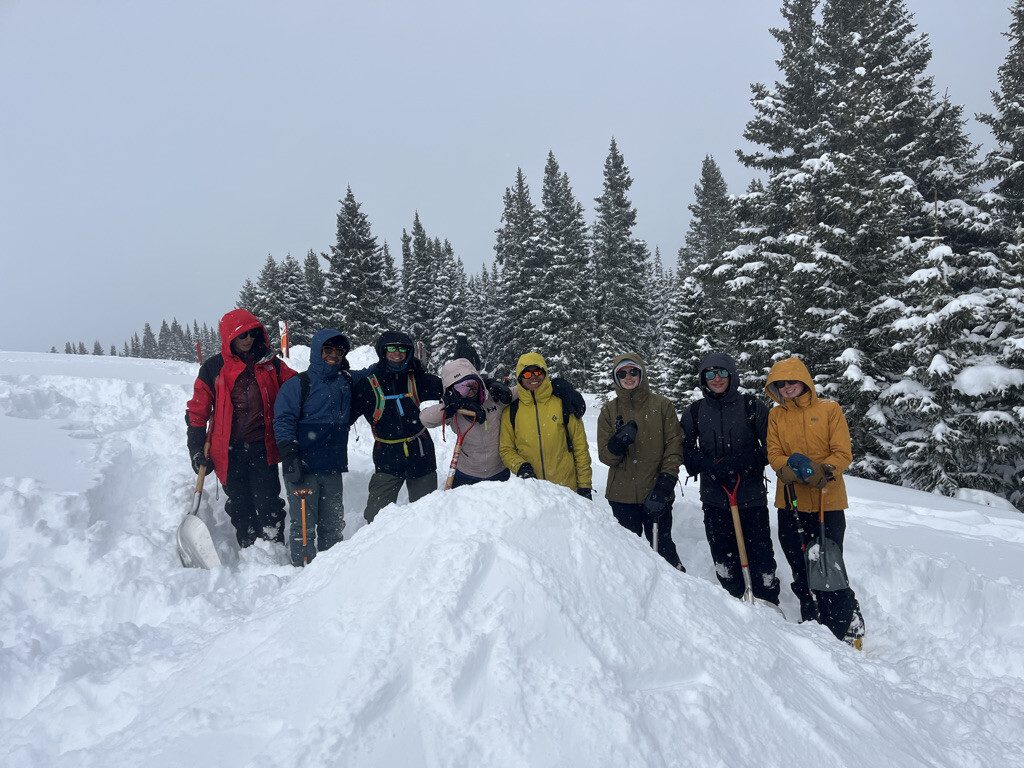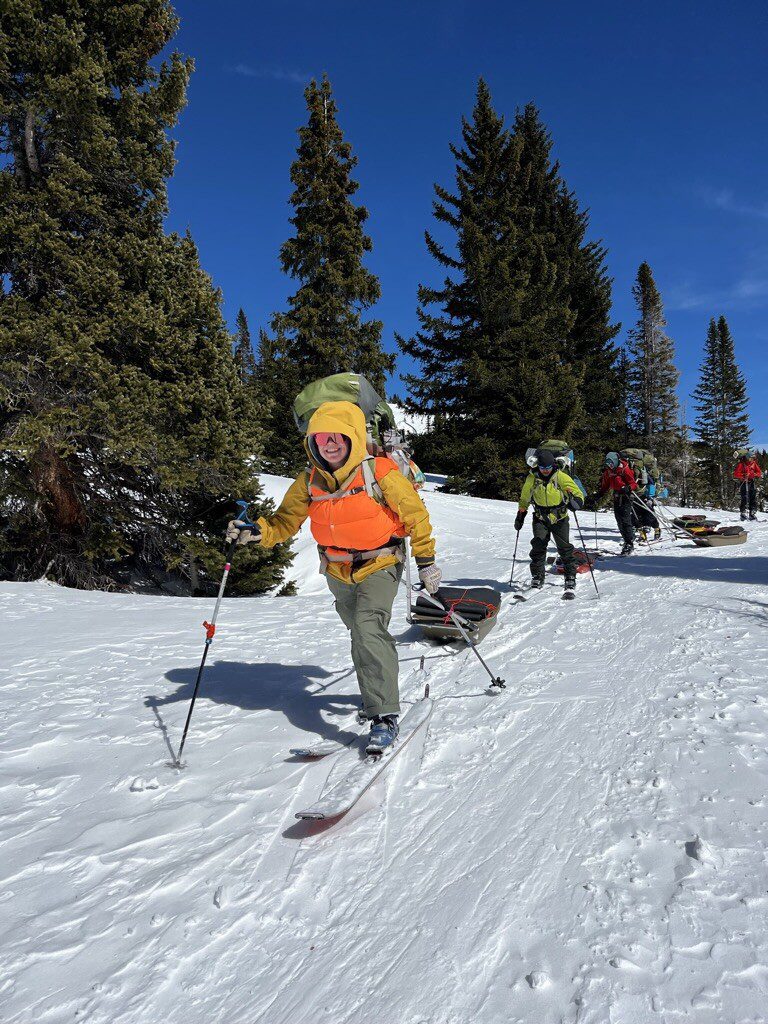Written by: Rafa, Coby, John
Hello all! From March 7-17, 2023, the students of HMI Semester 50 immersed themselves in another expeditionary journey. This time, donning backcountry Telemark skis, packs, and many, many insulated layers and towing sleds behind laden with provisions fit for ten nights in the still frosty mountains, they entered the backcountry of Leadville’s own backyard: the Sawatch!
After braving consistent sub-zero temperatures and often inimical environmental conditions in the beautifully austere spring mountains, all these intrepid HMI students successfully returned home to campus. Three of them have managed to find some extra time inside of their busy academic schedules since returning to campus to write and tell the world of their experiences!

Rafa: Greetings! To whomever is reading this, my name is Rafael Arellano. I am a part of HMI’s one and only Semester 50 and a proud resident of the Bronx, NY!
We just got back from our second expedition and I would love to share my experience with you. Before HMI, I had never backpacked, camped or skied. Back in the Bronx, there isn’t much access to go and explore the backcountry so I am very grateful that I took advantage of applying to HMI thanks to Prep for Prep, an academically challenging program headquartered in New York City that sends students of color to private and boarding institutions. After going on my first expedition in the canyons of Utah, and learning how to ski here during HMI’s Ski Week at Ski Cooper, I was confident that I had a grasp on how to manage myself going into this very challenging backpacking trip! I also want to make it clear that this isn’t any ordinary backpacking trip, it is a ten day backpacking trip in the Sawatch and Mosquito Ranges here in Leadville, CO, the highest incorporated city in the United States.
Going to this very hostile environment was extremely nerve racking! As for myself, I didn’t know what to expect besides the frigid temperatures. I also would love to point out that this expedition into the mountains of Leadville was not going to be easy. When the expedition began, we got our skis, backpacks and sleds. Yes, sleds. Throughout this entire trip we had to haul along our group gear such as a stove board, stoves, tents and many more essentials. Day 1 was the start of another adventure and my expedition group traversed about a mile and a half in the snow to our first campsite. Once we arrived, we instantly got ourselves ready for the night. Thanks to our amazing Instructor Team, they had already mounded a snow kitchen. This snow kitchen is where we would do all of our cooking for breakfast, lunch, appetizers, and dinner. In terms of rations and what we ate, this expedition was different from others. HMI gave our cook crew frozen appetizers like dumplings, mozzarella sticks, spring rolls, and sweet potato tots to fill us up so we can create as much body heat as possible. I would say that my cook crew and I really enjoyed cooking and eating our creations. As we continued our skinning up the mountains, we would go to our future campsite, mound our quigloos, a combination of an igloo and quinzhees (more to come), and snow kitchen for when we would arrive for good later. Mounding our quigloos and leaving it for a day allows the snow to solidify and make sure that the quigloos don’t fall on us while we are sleeping at night.
As we arrived at our first quigloo site, a very challenging skin upward, we got our shovels out and got right to work. We excavated the inside of our quigloos and again got our snow kitchens settled. Although it may sound extreme, the inside of our quigloos were fairly warm, sitting at around 0* degrees to 5* degrees Celsius, which is about 32* degrees to 41 degrees Fahrenheit. We placed our groundcloths, foam pads, and sleeping pads in our new six-foot-squared quigloo homes and stayed there for about four days. We then headed over to our next quigloo site to mound again, using the same process as before. As I said before, I had never backpacked, camped or skied before so all of this was very outside my comfort zone, and the reason why I came to HMI. A simple schedule of days we stayed in our quigloo sites would be breakfast at around 8:30 am, a lesson from the I-Team, lunch at 12pm, study hall till 4:30pm, Appy Hour (where we cook our delicious appetizers), dinner until 6:45 pm and finally circle at around 7:15. Circle is a time where everyone shares about their days and debriefs. This is often the time where everyone gets to know everyone else a little bit better each night.
As mentioned before, this was not an easy ten-day trip. While there were many low points however, there were many high points such as skiing down the amazing powdery snow. A memory that I will always cherish would be skiing down the mountains of Leadville on the last day. And because I am a beginner at skiing I did fall, multiple times, but the views you get and feeling of resilience are what make these unique memories at HMI. These are once in a lifetime opportunities, and I doubt that I will ever dig out a quigloo and live in it for ten days again. After all, it was great to experience and hope to enjoy the rest of my time here at HMI!

The five student expedition groups, each containing approximately ten individuals plus three or four instructors, were spread throughout the backcountry surrounding Leadville in the Sawatch and Mosquito regions of Colorado—some of the tallest mountains in the contiguous United States. Most groups found themselves situated in the dense spruce and lodgepole forests in San Isabel National Forest, camping beneath the rocky and icy crags which climbed thousands of feet overhead even still. Students slept under tarps and in quigloos—temporary snow shelters by night, and by day, explored the surrendered stillness of the winter environment!
Coby: You wake up in a quigloo, a snow structure which consists of a hollowed out dome of snow, and as you crawl through the narrow pathway leading out into the snowy landscape, something in the air feels right. The sun is shining brightly; it’s warm, clear weather, and last night’s snowfall is a thin layer of fresh powder on the ground. Today is the day: we’re going ski touring.
Backcountry skiing requires a few things. First, obviously, is the skis. We all used telemark skis, which allow you to lift up your heel while turning and going downhill at approximately “oh my god I’m going way too fast” miles per hour. Second, the poles. Finally, the skins. These stick to the bottom of your skis and give you traction for going uphill. They look like a thin layer of animal fur, with fibers going against the snow in order to stop you from sliding backwards. Armed with all these things, some familiar, some foreign, we set out. First we went to the “local ski hill,” a close-by, visible, easy hill. We walked to the base, preparing to climb up it. The skins, along with things called heel raisers (which do exactly what they sound like, make it easier to walk up steep terrain by elevating the heel) made our walk up easier. At the top, while catching our breath, we took off the skins. Then, finally, we went downhill. Even as a relatively experienced skier, this skiing was harder and stranger than anything I’ve done, the snow was sticky yet hard, the skis were unusual and strange, and my body was tired and cold, but, even so, it was exhilarating.
Much better than the local ski hill was our second destination. Taller, steeper, and scarier, this hill loomed above us looking like a mythic giant. We climbed up, again using the skins and heel raisers, and as we passed the treeline, a vast view of mountains opened up to us. Far below, we could see our camp, and we could see how small our camp was in comparison to everything else.
In that instant, a realization washed over me. Yes, the ski down is exhilarating, exciting, and awesome, but just as important is the walk up. The sweat, tears, occasional blood. The views, exhaustion, feeling of accomplishment at reaching the top. All are important and equally as rewarding.

John: My second expedition started off differently than everyone else, so the beginning of this story will be a recollection of what it is like to be alone on the HMI campus.
I joined everyone in the packing of our bags and was immediately happily surprised by how little stuff we were taking. I fit all of my things into my trusty 75 liter Lowe Alpine backpack (which many had assured me would not be able to fit all of my things). I only packed a couple changes of underwear and socks, and all of my warm layers. All of our group gear was being packed into big duffel bags. It was at this point that my sickness started to really set it, so I packed my bag as fast as possible, then laid down on the cold floor while everyone else prepped. I was sweating profusely and felt sick as a dog, so that morning I made the call to stay behind on campus with a few others so I could rest up and feel better. I waved goodbye to my healthy and happy comrades and immediately went back inside. That day consisted of me sleeping restfully in the comfortable armchair in Hope Classroom for multiple hours. The next day, I was informed that I would either have to enter the backcountry and join my group, or go home. Because I did feel better that day, and because a plane ticket back to Seattle is quite expensive, I decided to go in. Because I felt bad about missing the two hardest days, that morning I baked a whole bunch of chocolate chip cookies for my friends and packed them in for everyone.
I drove with Sophie to the trailhead where Justin was waiting to pick me up and I was feeling apprehensive the whole drive up—there was a surprising lack of snow in the valley. After meeting with Justin and having a rousing journey up the skin track, we met up with the group to the sound of cheers from all as I revealed the cookies from my backpack. The next day we packed all of our stuff up and skinned up to our next site where everyone else had mounded up tons of snow for the quigloos. The skin up was not as difficult as I expected it would be, but the candy bar I ate on the top still felt great. After digging out the quigloos we settled in for the night. The next few days were slightly uneventful except for an excellent backcountry ski through waist deep powder where I landed a solid jump and skied one of the best glade runs ever. The skiing that day was some of the best skiing I’ve experienced and will stay with me as a lifelong memory. After four days, we finished up at that quigloo site and we made our way to the top of Liberty Hill, an exposed peak with an elevation of around 12,500 feet. Digging out those quigloos was not fun at all that day; the wind was blowing at around 30mph and the snow was piling all around.
The next day a handful of us skied down a south facing slope where the sun hadn’t totally baked the snow. This skiing I will also never forget, because the snow was utterly immaculate and there were so few of us on this day trip. I was carving perfect lines into the waist deep snow that had a sun crust about half a foot down, and I was feeling ecstatic. But let me tell you, skinning back up those slopes really makes you appreciate a ski lift. We saw the prints of a fox on the way up and that was pretty cool. As we headed to our pick up spot on the last day, I bombed down a huge hill with my skins on and a huge sled behind me. It was a wonder I didn’t fall. I am now realizing I spent about as much time talking about how I was sick on campus as I did talking about the super cool backcountry skiing we did. Oh well! All things considered, it was still such a memorable trip!
